USA Takes on the Ninth World Foxhunting Championships
Nyiregyhaza, Hungary, September 1998
by Joe Moell KØOV
From an feature article in the March 1999 issue of CQ-VHF Magazine
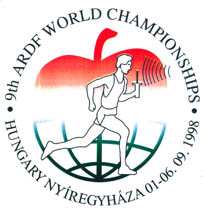 Why would almost 250 people from all walks of life come from 32 countries to an
eastern European forest? Why would they run and walk through the countryside
with strange looking antennas and beeping receivers? Answer: To find wily
radio "foxes" and win medals doing it!
Why would almost 250 people from all walks of life come from 32 countries to an
eastern European forest? Why would they run and walk through the countryside
with strange looking antennas and beeping receivers? Answer: To find wily
radio "foxes" and win medals doing it!
Most hams have heard of the sport of hidden transmitter hunting, which goes by
the nicknames foxhunting and T-hunting. In North America, foxhunts usually
involve a drive through town and country in a vehicle full of radio direction
finding (RDF) gear. But elsewhere in the world, especially in eastern Europe,
Scandinavia, and the Far East, there are no cars in a foxhunt. It's an
athletic event in a big park or forest. Sometimes it's called
radio-orienteering, because the participants use a map and compass along with
RDF gear to search for five "controls" (foxes) and mark their cards with the
orienteering punch at each fox. Other names for this on-foot sport are
fox-teering, foxtailing and Amateur Radio Direction Finding (ARDF).
Rules for stateside mobile transmitter hunts depend on local preferences. Some
boundaries are large, others are small. Some are scored by time, others by
mileage, and so on. On the other hand, radio-orienteering rules have been
standardized by the International Amateur Radio Union (IARU). That makes it
possible to hold championships at the national, regional and world levels.
Since 1980, ARDF Working Groups of the IARU have put on such events.
Participating countries hold national championships every year, whenever
possible. IARU Region 1 (Europe/Africa) and Region 3 (Asia/Oceania)
championships usually take place in odd-numbered years. There is a World
Championship meet in even-numbered years.
USA Joins the Fun
Prior to 1998, North American hams had observed the ARDF World Championships,
but had never entered the fray. Interest in the sport has been growing here,
though. There were radio-orienteering competitions at California hamfests
during 1995 and 1996. The Friendship Amateur Radio Society (FARS) had put on
ARDF events in Oregon (1991) and British Columbia (1993) with hams from Russia,
Japan, Canada and USA on the course. In 1996, Kevin Kelly N6QAB traveled to
Townsville, Australia to represent USA in the IARU Region 3 Championships.
This growth in foxtailing interest, plus some gentle prodding by IARU ARDF
leaders in Europe and Asia, is finally beginning to be recognized by the
national societies of Region 2. In 1997, Radio Amateurs of Canada appointed
Perry Creighton VE7WWP as national ARDF Coordinator, the first for both Canada
and the Americas. Perry is no stranger to the sport, having put on the 1993
Friendship Radiosport Games foxhunt in his home city of Victoria, BC.
The ARRL followed suit in February 1998 by appointing me as the USA's first
national ARDF Coordinator. One of my first goals was to have USA compete in
the ARDF World Championships for the first time. That event would be in
Hungary and I would be unable to go because of other commitments. Fortunately,
Dale Hunt WB6BYU of Yamhill, Oregon stepped forward and agreed to lead the
team. Dale's first foray into the world of ARDF had occurred a year earlier,
when he went to Japan for the 1997 Friendship Radiosport Games. At that event,
he finished first among all entrants from North America.
Other members of the USA delegation were Jack Loflin KC7CGK, Marvin Johnston
KE6HTS, Barbara Johnston KE6OTF, Dennis Schwendtner WB6OBB, and Gyuri Nagy
HA3PA. KC7CGK was 17 years old and lives 7 miles from WB6BYU. Jack had
attended the 1997 Friendship Radiosports Games ARDF competition in Japan, where
he won the gold medal in his division. His other RDF activities include
tracking aircraft Emergency Locator Transmitters with the Civil Air Patrol.
KE6HTS, KE6OTF and WB6OBB live in Santa Barbara, California. Marvin is an avid
transmitter hunter, both mobile and on foot. He has participated in two formal
ARDF competitions in the Los Angeles area, winning first place in his division
at one of them. His wife Barb accompanied him as observer and photographer.
Dennis is a piano tuner who has been on mobile transmitter hunting teams for
many years. He would like to compete in the World Championships when and if
the IARU rules are changed to accommodate handicapped participants. (He is
blind.) Meanwhile, he served as the official USA Team Trainer.
HA3PA is a native of Hungary who has won medals in prior ARDF World
Championships. Because of his resident alien status in the United States, he
was able to compete on our team. Gyuri generously provided additional 80 meter
ARDF receiver/antenna sets for use during the Championships. This was welcome,
as our equipment-building efforts have primarily been for two meters so far.
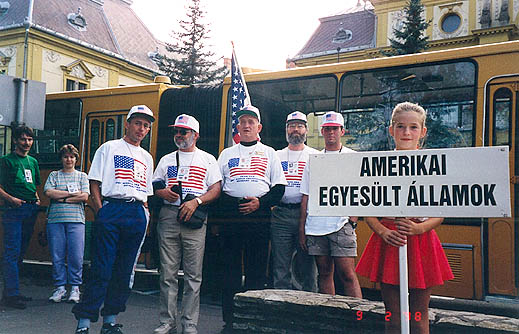
Team USA lines up behind its national placard, ready to march through
the streets. Left to right are Gyuri Nagy HA3PA, Marvin Johnston KE6HTS,
Dennis Schwendtner WB6OBB, Dale Hunt WB6BYU and Jack Loflin KC7CGK. (Photo by
Barbara Johnston KE6OTF)
Once formed, the next problem for Team USA was getting to Hungary. Because
there is no formal ARDF organization in the USA to raise funds, each person had
to arrange and pay for transportation and entry fees. Thanks to some
behind-the-scenes work by ARRL Executive Secretary David Sumner K1ZZ and
others, a grant was obtained from the Colvin Foundation to help defray these
costs.
Welcome to Hungary!
What's it like to attend a World Championship foxhunt? Well, it's much like
the Olympics, with world-class athletes doing their best, individuals and
national teams vying for medals, lots of pomp and ceremony, and a bit of
haggling over rules and procedures. The site was in Nyiregyhaza, a major city
on the eastern side of Hungary, about 150 miles from Budapest. Housing was
provided at dormitories of Bessenyei Gyorgy Teachers Institute.
"The dorm was pretty nice, though the bathrooms were on the 'iffy' side,"
KC7CGK reported. "There were pairs of double rooms, split in the middle with a
bathroom. Since there was only one person occupying each half, there was
plenty of room. There also was a gym, swimming pool and tennis courts."
"The city was like any other European city," Jack continued, "It seemed like
anything you wanted was available. But if you went out of town a little ways
you could find horse-drawn carts and houses with mud floors and walls."
Americans visiting Hungary is unusual enough, but Americans at a Hungarian
radiosports event was unprecedented. KC7CGK observed, "It was interesting
going from a country where foxhunting is merely a weekend hobby for just a few
hams to a country where it is viewed as we regard soccer. I was impressed."
The Championships opened in grand style with a ceremony in the town plaza.
Thousands watched as athletes marched through the streets and the mayor and
City Parliament members welcomed them. Then there was folk dancing, baton
twirling and other entertainment.
"We found some young girls with signs identifying the countries," KE6HTS said.
"We figured USA would be near the end of the line, but instead we were first
since our sign read 'Amerikai.' Each team carried its national flag on a
staff. At the last minute, we found we did not have a staff for the Stars and
Stripes, so we used Dennis' white cane! It was quite an experience walking at
the front of such a procession and being observed and photographed by all the
townspeople."
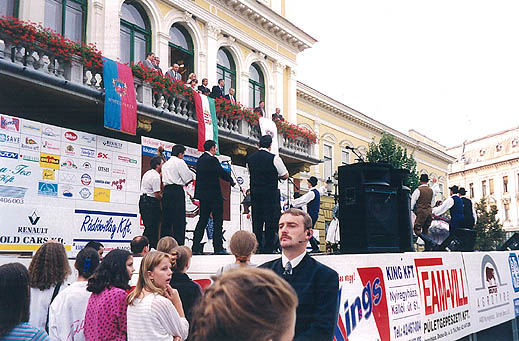
At the opening ceremonies, there was marching, music, folk dancing,
speeches from dignitaries, and plenty of security. (Photo by Barbara Johnston
KE6OTF)
Jack said that it was difficult to find people out on the streets who spoke
English. However, the ceremonial speeches were all translated into English and
it was the official language of the Championships. Dale reported that most of
the attendees at the Team Leader meetings spoke good English.
Ham Versus Ham
"The words '9th ARDF World Championships' really began to take on some meaning
when we saw the various teams assembling for the competition," said KE6HTS .
"It was rather impressive knowing we were in the company of the best ARDF
people in the world. It was also quite a humbling experience."
ARDF championships have two competitions, held two days apart. One has
two-meter transmitters, the other is on the 80 meter band. At 0700 on the day
after opening, busses began to take competitors to the two-meter site.
"At this point, none of us knew where the competition would take place," Marvin
reported. "An hour later, we arrived. The whole area was roped in, and once
inside, no competitor was allowed to leave. Our RDF equipment was put into a
special area on racks, and could only be retrieved when we were called to the
starting box.
"Ten minutes before assigned start time, competitors received an orienteering
map," KE6HTS continued. "There was a small triangle marked for the start and
small concentric circles at the finish line. Additionally, they received the
card to punch at each transmitter. Five minutes before assigned start time,
competitors were called into the start area where they checked equipment,
studied maps, and made ready to begin. There were two starting corridors, one
to the left for Women and Seniors and one straight ahead for Juniors, Old
Timers, and Veterans.
"Almost everyone started out at a run, or at least all those who stood a chance
of winning! Since start times were five minutes apart and only one competitor
of each division could start at the same time, it would be about five hours
before everyone had begun. The assigned starting times were drawn from a hat
during one of the many meetings that the Team Captains attended. The time
limit for this heat was 130 minutes.
"At my assigned starting time, I jogged out of the starting corridor, turned on
my equipment, and started taking bearings. As I went along, my bearing to fox
#1 was almost due east, fox #2 was northeast, #3 was pretty much north, and #4
was WNW. Judging from signal strengths, #4 seemed to be the one to find first,
so I headed along the road and turned east at the first junction. Shortly
thereafter, I lost where I was on the map. I was pretty sure that the proper
order to find the transmitters was 4, 3, 2, 1 and finish. Since I didn't know
where I was, I just started following the bearings. Fox #4 turned out to be
just on the other side of some brush along a trail. My elapsed time was 40
minutes at this point.
"The terrain was relatively flat with areas ranging from open fields to fairly
dense brush, difficult to run through quickly. There were both harvested as
well as unharvested cornfields, areas where trees had been planted in rows, and
some places with freshly plowed dirt that was very difficult for running. The
orienteering map showed the details on most of this---for those that could read
and understand it! I headed directly towards #3. This caused slow progress
since I didn't know how I could go around difficult terrain. After crossing
relatively clear areas to some denser forest and traveling another 400 meters
or so, I found #3 with an elapsed time of a little over an hour.
"With #2 now having a bearing of ESE, I headed in that direction. I found
myself traversing a freshly tilled grove of trees that made walking, let alone
running, very tiring. As I then crossed a clear field, I kept thinking the
transmitter was only 100 meters or so away. About 300 meters later, I finally
got to it with an elapsed time of just over an hour and a half.
"At this point, I was getting pretty tired from fighting the terrain. I had a
clear bearing to #1 as well as to the finish, but time was getting tight. I
knew I could find #1, but I wasn't sure if I could then make it back to the
finish in time, given how tired I was becoming. So I decided to make sure I
got to the finish without being disqualified. It turned out to be a good
choice. Even if I had found #1 and made it in time, it would have only made a
difference of one place in the standings."
Meanwhile, officials were keeping a close watch on all the competitors. "At
each transmitter there were two referees linked with 440 MHz radios to the
finish area," KC7CGK reported. "As you got to each transmitter, they took down
your number and checked who was just before you and just after you. If, for
example, I had come in just behind competitor number 34 at all 4 foxes, they
would be suspicious. At the finish, there was a board with everyone's name and
the time they found each fox, updated in near real time."
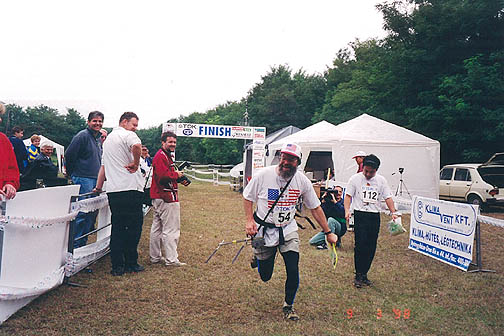
Team Captain Dale Hunt WB6BYU sprints down the finish corridor at the
end of the 2-meter event. (Photo by Barbara Johnston KE6OTF)
Winning times on the two meter course for the five divisions ranged from 45 to
75 minutes. Gyuri did it in just under 70 minutes. All Team USA members got
back with at least nine minutes to spare. Except for the one Marvin missed,
all Team USA members found all foxes. As Dale crossed the finish line, he
spread his arms out and yelled with excitement, just as a photographer snapped
him. That photo showed up on the sports page of the local newspaper the next
day.
Competitors, But Elmers Too
Despite the fact that this gathering would determine who are truly the world's
best radio-orienteers, the contestants were willing and eager to share their
knowledge of this sport and their tricks of the trade, as Marvin soon
discovered. "After dinner, Jack and I were invited by Tcherman Gouliev UA3BL
to his room where he explained the best use of equipment, strategy, and how to
train for ARDF events. Tcherman is the Russian team leader and Chief of the
Moscow Radio Club. Since he had previously won 6 gold medals, we were honored
that he would take time to share his experiences." UA3BL and WB6BYU then
worked into the night realigning Dale's 80 meter set to give it more
sensitivity.
The next day was to be for rest before the 80 meter event, but it also included
a five-hour tour of a local museum, followed by a program of folk dancing and
music. HA3PA and KE6HTS decided to skip the afternoon part to get some
last-minute practice in 80 meter foxtailing using Gyuri's transmitters and
receivers. "Gyuri was an excellent trainer," Marvin recalled. "The three
hours we spent turned out to be very helpful."
The next morning, all boarded the busses to a different location for the 80
meter heat. "Dale turned out to have a starting time of 0:00 (first group),
while I had 0:40," said KE6HTS. "Gyuri felt really happy that he received a
starting time of 3:05, since that would put him almost last out of the gate.
Many trails of previous competitors would be visible, giving him hints about
transmitter locations."
Marvin had a better time on 80 meters. "I started out of the corridor for the
Old Timers heading north. As soon as I reached the end of the corridor, I
turned on my receiver and got a bearing on fox #1 almost due north. As I ran
that way, I got bearings on #2 somewhat to the right, #3 about northwest, and
#4 about northeast before I had to make a decision on the order I would seek
the transmitters. I had a pretty good idea that #4 was closest and ran toward
a road that would take me in that direction. Heading down the road, I knew I
was close by the both bearings and signal strength. When I saw another good
competitor entering the road from the field, I headed that way and followed the
tracks on the ground. When #4 went on, I was only a few hundred feet from the
location and found it without difficulty. With an elapsed time of about 25
minutes, there was one down and three to go."
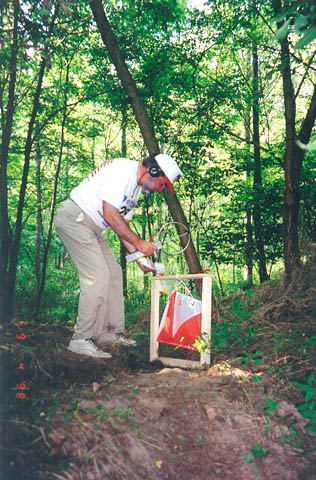
Marvin Johnston KE6HTS got the judge at 80 meter fox #4 to snap a
photo of him punching his card. Note the prominent orange and white
orienteering flag that helps hunters spot the foxes.
"Heading back to the road, I had already decided that the order I would get the
other transmitters would be 3, 2, and 1. So I headed back west. When I found
a trail in the direction of #3, I took it. It turned out to be the correct
decision and I found the transmitter about 10 minutes later. Finding a road
that seemed to lead towards #3, I alternated between walking and running.
Transmitter 3 turned out to be at the end of that road.
"With only about 70 elapsed minutes, I headed up to find #1. Although I had
plotted its direction from the start, the line I had drawn was not dark enough
on the map and I missed it. The result was taking the wrong course to #4 which
ended up costing me about 15 minutes. After finding it, I was off to the
finish line about 1200 meters north. Alternating between running and walking,
I followed both the map and the DF bearings. It is not acceptable to walk the
corridors, so I huffed and puffed along for several hundred meters until I
passed the finish line."
Their early start times gave Marvin and Dale the opportunity to track Gyuri's
progress throughout the course and to watch many others as they finished. "It
was interesting because some teams had runners that carried their national flag
alongside team members as they arrived at the finish line," Marvin remarked.
Most ARDFers say that foxtailing on 80 meters is easier than on two meters.
Eighty-meter RDF equipment is smaller and lighter. There are fewer signal
reflections on 3.5 MHz to confuse the hunters. Winning times for the various
divisions were two to 16 minutes better than for the same division on two
meters. UA3BL, who had helped Dale optimize his receiver, won the gold in his
division.
All members of Team USA had a better day, and found every fox. Gyuri cut
almost 15 minutes off his two meter time and finished 17th among the 65 Senior
division competitors. Jack did over 20 minutes better. "He beat the whole
Japanese Junior team," Dale said proudly.
"I was more organized," KC7CGK explained. "The course was in the shape of an
arrow pointing up, the start point in the bottom left corner and the finish at
the tip top. I ran north about five minutes until the road ended and by that
time I knew that there was a transmitter to the west, one straight ahead, and
the other two were to the right. I went to the left one first, and then headed
east and got the two on the right, then came back to the center, got the last
one, and headed to the finish. I don't think I did better RDF, it's just that
I kept running a little longer. I didn't know what to expect the first day and
I think I let myself slack off. The second time I really pushed myself."

Competitors' clock times at each fox were relayed by jury members at
the foxes to the finish area, where they were posted for all to see. (Photo by
Marvin Johnston KE6HTS)
When Is The Next One?
"This was a great ham event!" That's how Team Captain WB6BYU summarized the
Championships. "The people were quite friendly, and glad finally to have
representatives from Region 2. For a relatively inexperienced team, we did
well." Marvin added, "They said that for the first time it was truly a world
championship."
Congratulations to Team USA members for their fine performances, and my
personal thanks to all of them for eagerly telling their stories for CQ-VHF
readers. All of them are looking forward to future ARDF competitions and they
want many more hams to join in. It's not difficult, but it requires a bit of
skill that is easily obtained with practice. It's a great way for all ages to
exercise, especially youth. Why not get your local Scout troops involved?
Figure 1. In the two-meter competition on September 3, there were 64 Seniors
(OMs), 45 Juniors (JRs), 47 Women (YLs), 60 Old Timers (OTs) and 28 Veterans
(VTs). These were the winning countries.
INDIVIDUAL MEDALS
OM JR YL OT VT
GOLD Czech Hungary Ukraine Hungary Russia
SILVER Russia Czech Ukraine Ukraine Ukraine
BRONZE Ukraine Czech Hungary Russia Russia
TEAM MEDALS
OM JR YL OT VT
GOLD Czech Czech Ukraine Russia Russia
SILVER Russia Russia Russia Hungary Germany
BRONZE Ukraine Ukraine Czech Ukraine Ukraine
Figure 2. In the 80-meter competition on September 5, there were 59 Seniors,
43 Juniors, 47 Women, 65 Old Timers and 28 Veterans. These were the winning
countries.
INDIVIDUAL MEDALS
OM JR YL OT VT
GOLD Czech Czech Belarus Russia Ukraine
SILVER Germany Russia Ukraine Russia Hungary
BRONZE Ukraine Romania Czech Lithuania Czech
TEAM MEDALS
OM JR YL OT VT
GOLD Russia Czech Ukraine Russia Russia
SILVER Czech Russia Hungary Ukraine Ukraine
BRONZE Ukraine Slovakia Slovakia Hungary Germany
NOTE: In 1998, there were only five age/gender categories, four for males and one for females. Today there are many more age/gender categories.
© 1999 and 2008 Joseph D. Moell. All rights reserved.

 Back to the Championships Foxhunting News page
Back to the Championships Foxhunting News page
Back to the Homing In home page
This page updated 10 November 2010
 Why would almost 250 people from all walks of life come from 32 countries to an
eastern European forest? Why would they run and walk through the countryside
with strange looking antennas and beeping receivers? Answer: To find wily
radio "foxes" and win medals doing it!
Why would almost 250 people from all walks of life come from 32 countries to an
eastern European forest? Why would they run and walk through the countryside
with strange looking antennas and beeping receivers? Answer: To find wily
radio "foxes" and win medals doing it!





